Revision Notes for CBSE Class 11 Maths Chapter 10 (Conic Sections) - Free PDF Download
Class 11 Maths is the foundation subject for professional courses one pursues after completing the Higher Secondary level education. The 11th chapter of this subject represents the conic sections and the formulas that represent these sections. Previously, you have studied different kinds of equations representing a straight line. Now, you will proceed to represent a shape that can be extracted from a conic section. in this chapter, you will learn what circles, parabola, ellipse, and hyperbola are. All these conic sections can be represented with an equation. A genre of conic section always obeys a particular type of equation developed using coordinate geometry.
To understand these sections, consider referring to the Class 11 Maths Chapter 10 Revision Notes so that you can quickly recall the equations and prepare this chapter before an exam. Using revision notes can be very helpful when you have less time to recap the chapter. Vedantu has created some easy ways to remember formulas with Class 11 Maths Revision Notes so that the students can easily revise and remember the formulas. Check how efficiently the experts have a quick recapitulation with Class 11 Maths Chapter 10 Revision Notes to enjoy studying this chapter.
Conic Sections Class 11 Notes Maths - Basic Subjective Questions
Section–A (1 Mark Questions)
1. The equation of circle, which passes through origin and has centre at (–1, 4) is ________.
Ans. We know that,
Equation of circle with centre (h, k) and passes through the origin is
Thus, the equation of required circle with centre (-1, 4) is-
2. For parabola y2=-16x, find the equation of directrix.
Ans. Given: Equation of parabola: y2=-16x
Since the given parabola is of the form y2=-4ax
Thus, on comparison we get,
16=4a
Therefore,
Equation of directrix: x = a i.e., x = 4.
3. For the ellipse
Ans. Equation of ellipse:
Since denominator of x2 > denominator of y2
We get, a = 9 and b = 3
Thus, Coordinates of end points of major axis are
4. For the hyperbola
Ans. Equation of hyperbola:
Since the given hyperbola is of the form \frac{x^{2}}{a^{2}}-\frac{y^{2}}{b^{2}}=1
Thus, on comparison we get, a = 4 and b = 2
Therefore,
Length of transverse axis
5. Find the equation of parabola with vertex (0, 0) and focus (0, -7)
Ans. Since the vertex is at (0, 0) and focus is at (0, –7), i.e., on y -axis
Thus, y - axis is the axis of parabola.
Hence, the equation of the parabola is of the form
Therefore, equation of parabola is given by
Section–B (2 Marks Questions)
6. Find the equation of the circle which touches the y-axis and centre (2, 4).
Ans. Since, the circle is touching y-axis.
The length CP is equal to the radius of the circle.
Thus, Radius = CP = 2.
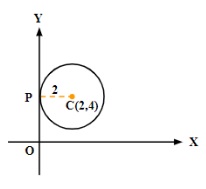
Hence, the equation of the required circle is
7. Find the length of latus rectum of the hyperbola
Ans. Equation of hyperbola:
Since, the given hyperbola is of the form
Thus, on comparison we get,
Therefore, Length of latus rectum
8. Find the coordinates of the foci a of the hyperbola
Ans. Equation of hyperbola:
On comparing with standard equation of hyperbola
We obtain
Now, we know that,
Thus,Coordinates of foci are
9.Find the equation of the circle which touches the lines x = 0, y = 0 and x = -6.
Ans. Since, the circle is touching the lines
Thus, two such circles are possible
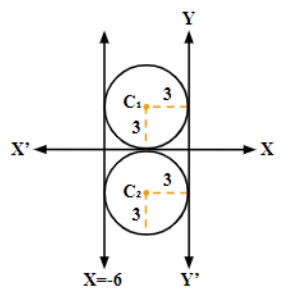
Thus, the equation of circles is-
10.Find the equation of a circle with centre (1, 3) and passes through the point (-1, -3).
Ans. Centre of the circle
Since the circle passes through point
The radius
Thus, the equation of the circle is given by-
11. Find the equation of the circle, when the coordinates of end point of diameter is given by (1, 1) and (3, 3).
Ans. We know that equation of the circle with diametric points
Thus, when the coordinates of end points of diameter are
Equation of circle:
12. Find the equation of the ellipse having ends of major axis
Ans. Given: ends of major axis
Since, the major axis is along
Accordingly,
Thus, required equation of ellipse is
13. Find the coordinates of the focus and equation of the directrix for the parabola given by
Ans. Given: Equation of parabola:
Thus, on comparison we get.
Therefore,Coordinates of focus:
Equation of directrix:
PDF Summary - Class 11 Maths Conic Sections (Chapter 10)
1. Conic Sections:
The locus of point which moves in a plane so that its distance from a fixed point is in a constant ratio to its perpendicular distance from a fixed straight line
The fixed straight line is called the Directrix
The fixed point is called the Focus.
The constant ratio is called the Eccentricity denoted by e.
A point of intersection of a conic with its axis is called a Vertex.
The line passing through the focus & perpendicular to the Directrix is called the Axis.
2. Section of Right Circular Cone by Different Planes:
Figure shows right circular cone.
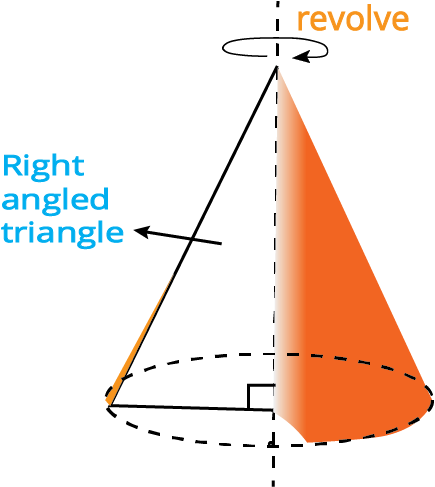
(i) Figure shows the section of a right circular cone by a plane passing through its vertex is a pair of straight lines passing through the vertex.
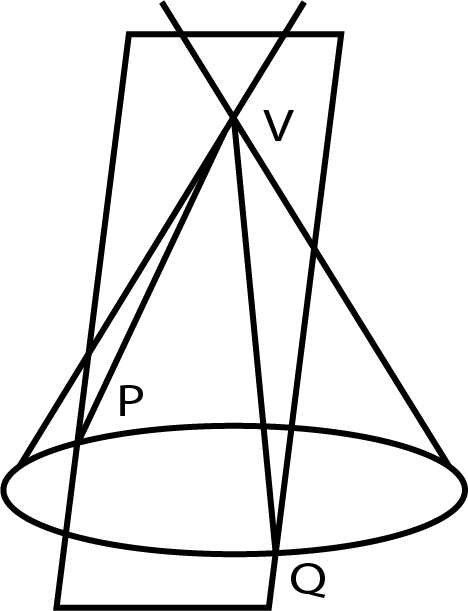
(ii) Figure shows section of a right circular cone by a plane parallel to its base is a circle.
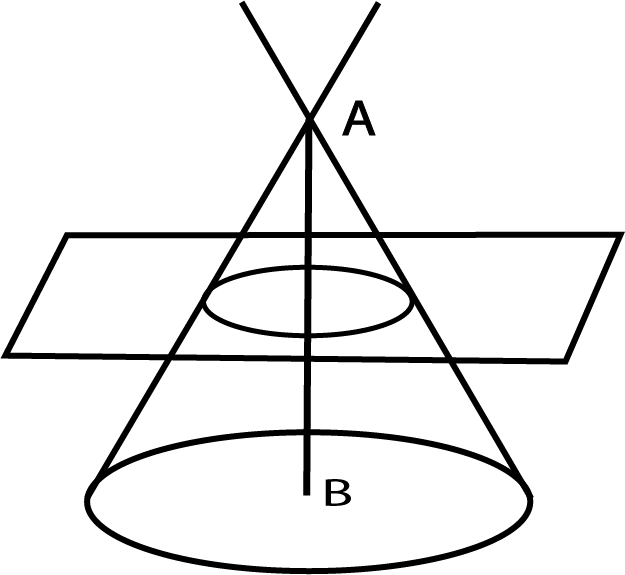
(iii) Figure shows section of a right circular cone by a plane parallel to a generator of the cone is a parabola.
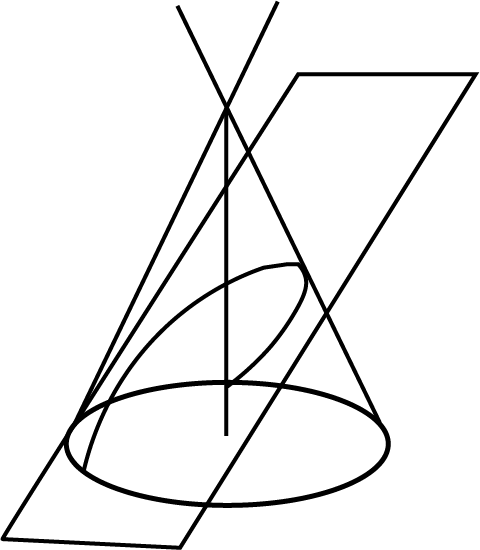
(iv) Below figure shows section of a right circular cone by a plane neither parallel to any generator of the cone nor perpendicular or parallel to the axis of the cone is an ellipse or hyperbola.
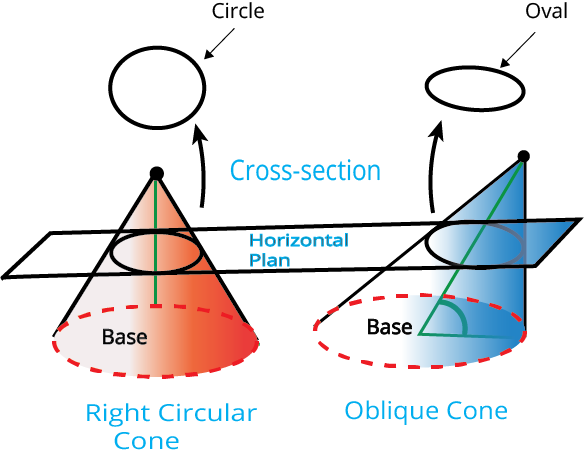
3D view:

3. General Equation of a Conic: Focal Directrix Property.
If focus of conic is
4. Distinguishing Various Conics:
The nature of conic section depends upon value of eccentricity as well as the position of the focus and the directrix. So, there are two different cases:
Case 1: When the Focus Lies on the Directrix.
In this case,
The general equation of a conic represents a pair of straight lines if:
Case 2: When the Focus Does not Lies on the Directrix.
A parabola
An ellipse
A hyperbola
A rectangular hyperbola
Parabola
Definition and Terminology
The locus of a point, whose distance from a fixed point called focus is equal to perpendicular distance from a fixed straight line called directrix is called Parabola.
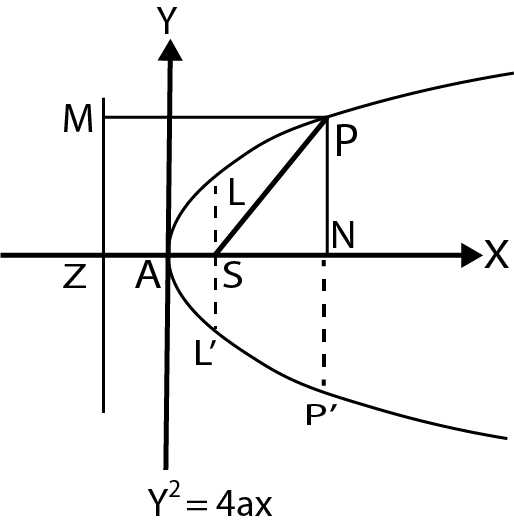
Four standard forms of parabola are:
For parabola,
(i) Vertex is:
(ii) Focus is:
(iii) Axis is:
(iv) Directrix is:
The distance of a point on the parabola from the focus is called focal distance.
A chord of the parabola, which passes through the focus is called focal chord.
A chord of the parabola perpendicular to the axis of the symmetry is called double ordinate.
A double ordinate passing through the focus or a focal chord perpendicular to the axis of parabola is called the Latus Rectum.
For,
Note:
Perpendicular distance from focus to directrix = half the latus rectum.
Vertex is middle point of the focus & the point of intersection of directrix & axis.
Two parabolas are said to be equal if they have the same latus rectum.
Position of a Point Relative to Parabola:
Point
Line and Parabola:
The line
Two real points if
Two coincident points if
Two non real points if
Condition of Tangency is
Length of chord that line
Note: Length of focal chord making an angle
Parametric Representation:
The equation of a chord joining
Note: If
Hence, coordinates of extremities of parabola are
Tangent to the Parabola
Note: Point of intersection of the tangents at the point
Normal to the Parabola
Note:
(i) Point of intersection of normals at
(ii) If the normals to the parabola
(iii) If the normals to the parabola
Pair of Tangents
The equation to the pair of tangents which can be drawn from any point
Director Circle
Locus of the point of intersection of the perpendicular tangents to a curve is called the director circle. For parabola
Chord of Contact
Equation to the chord of contact of tangents drawn from a point
Note: The area of the triangle formed by the tangents from the point
Chord With a Given Middle Point
Equation of the chord of the parabola
Ellipse
Standard Equation and Definitions:
Standard equation of an ellipse referred to its principal axes along the co-ordinate axes is
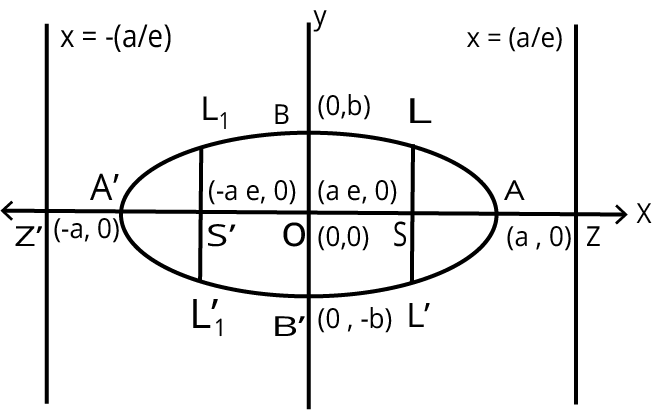
Eccentricity:
Foci:
Equations of Directrices:
Major Axis: The line segment
Minor Axis: The y-axis intersects the ellipse in the points
Principal Axis: The major and minor axis together are called principal axis of the ellipse.
Vertices:
Focal Chord : A chord which passes through a focus is called a focal chord.
Double Ordinate: A chord perpendicular to the major axis is called a double ordinate.
Latus Rectum: The focal chord perpendicular to the major axis is called the latus rectum.
Length of latus rectum (LL’) :
Centre: The point which bisects every chord of the conic drawn through it is called the centre of the conic.
The origin is the centre of the ellipse
Note:
(i) If the equation of the ellipse is given as
(ii) If
Auxiliary Circle/Eccentric Angle:
A circle described on major axis as diameter is called the auxiliary circle. Let
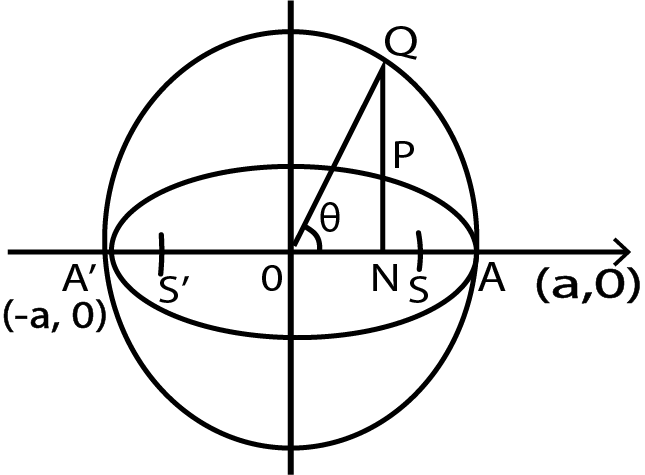
Note:
If from each point of a circle perpendiculars are drawn upon a fixed diameter then the locus of the points dividing these perpendiculars in a given ratio is an ellipse of which the given circle is the auxiliary circle.
Parametric Representation:
The equations
Where
Position of a Point With Respect to Ellipse:
The point
Line and an Ellipse:
The line
Hence
Tangents:
(a) Slope form
(b) Point form
(c) Parametric for
Note:
(i) There are two tangents to the ellipse having the same m, i.e. there are two tangents parallel to any given direction. These tangents touch the ellipse at extremities of a diameter.
(ii) Point of intersection of the tangents at the point
(iii) The eccentric angles of point of contact of two parallel tangents differ by
Normal:
(i) Equation of the normal at
(ii) Equation of the normal at the point (acos
(iii) Equation of a normal in terms of its slope m is
Director Circle:
Locus of the point of intersection of the tangents which meet at right angles is called the Director Circle. The equation to this locus is
Note:
Pair of tangents, Chord of contact, Pole & Polar, Chord with a given Middle point are to be interpreted as they, are in Parabola/Circle.
Diameter (Not in Syllabus)
The locus of the middle points of a system of parallel chords with slope 'm' of an ellipse is a straight line passing through the centre of the ellipse, called its diameter and has the equation
Note:
All diameters of ellipse passes through its centre
Important Highlights:
Referring to the ellipse
(a) If
(b) The tangent & normal at a point
(c) The product of the length's of the perpendicular segments from the foci on any tangent to the ellipse is
(d) The portion of the tangent to an ellipse between the point of contact & the directrix subtends a right angle at the corresponding focus.
(c) If the normal at any point
(i) PF.
(ii)
(iii)
(iv)
(v) locus of the mid point of
(Where
The circle on any focal distance as diameter touches the auxiliary circle. Perpendiculars from the centre upon all chords which join the ends of any perpendicular diameters of the ellipse are of constant length.
If the tangent at the point P of a standard ellipse meets the axis in T and t and CY is the perpendicular on it from the centre then :
(i) T t.P Y = a2 – b2 and
(ii) least value of T t is a+b
Hyperbola
The Hyperbola is a conic whose eccentricity is greater than unity
Standard Equation and Definitions:
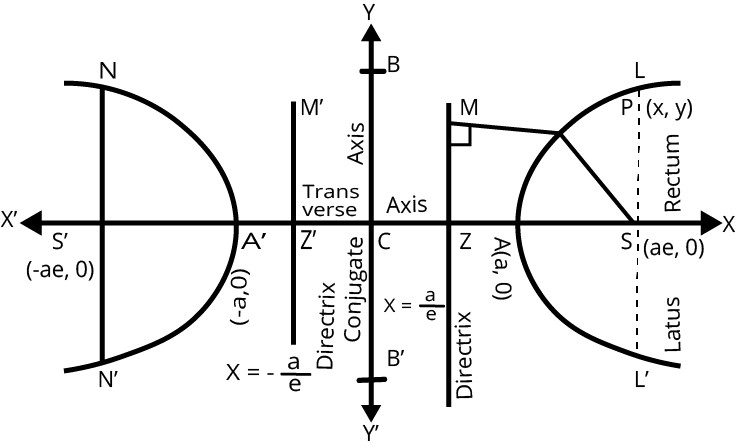
Standard equation of the hyperbola is
Eccentricity (e):
(C.A
(T.A.
Foci:
Equations of Directrix:
Transverse Axis: The line segment
Conjugate Axis: The line segment B'B between the two points
Principal Axes: The transverse & conjugate axis together are called Principal Axes of the hyperbola.
Vertices:
Focal Chord: A chord which passes through a focus is called a focal chord.
Double Ordinate:
Latus Rectum (l) L: The focal chord perpendicular to the transverse axis is called the latus rectum.
Note:
Centre: The point which bisects every chord of the conic drawn through it is called the centre of the conic
Since the fundamental equation to the hyperbola only differs from that to the ellipse in having
Rectangular or Equilateral Hyperbola:
The particular kind of hyperbola in which the lengths of the transverse and conjugate axis are equal is called an Equilateral Hyperbola. Note that the eccentricity of the rectangular hyperbola is
Conjugate Hyperbola:
Two hyperbolas such that transverse & conjugate axes of one hyperbola are respectively the conjugate & the transverse axes of the other are called Conjugate Hyperbolas of each other.
e.g.
Note:
(a) If
(b) The foci of a hyperbola and its conjugate are concyclic and form the vertices of a square.
(c) Two hyperbolas are said to be similar if they have the same eccentricity:
(d) Two similar hyperbolas are said to be equal if they have same latus rectum.
(e) If a hyperbola is equilateral, then the conjugate hyperbola is also equilateral.
Auxiliary Circle:
A circle drawn with centre C and T.A. as a diameter is called the Auxiliary Circle of the hyperbola. Equation of the auxiliary circle is
Note from the figure that P and Q are called the "Corresponding Points" on the hyperbola and the auxiliary circle.
In the hyperbola any ordinate of the curve does not meet the circle on

Parametric Representation:
The equation
Note that if
The equation to the chord of the hyperbola joining two points with eccentric angles
Position of a Point With Respect to Hyperbola:
The quantity
Line and a Hyperbola:
The straight line
Tangents:
(i) Slope Form
(ii) Point Form: Equation of tangent to the hyperbola
(iii) Parametric Form: Equation of the tangent to the hyperbola
Note:
(i) Point of intersection of the tangents at
(ii) If
(iii) There are two parallel tangents having the same slope m.These tangents touches the hyperbola at the extremities of a diameter.
Normals:
(i) The equation of the normal to the hyperbola
(ii) The equations of the normal at the point
(iii) Equation of a normal in terms of its slope 'm' is
Note:
Equation to the chord of contact, polar, chord with a given middle point, pair of tangents from an external point is to be interpreted as in parabola/circle.
Director Circle:
The locus of the intersection point of tangents which are at right angles is known as the Director Circle of the hyperbola. The equation to the director circle is :
If
If
If
Diameter (Not in syllabus):
The locus of the middle points of a system of parallel chords with slope 'm' of an hyperbola is called its diameter. It is a straight line passing through the centre of the hyperbola and has the equation
Note: All diameters of the hyperbola pass through its centre.
Asymptotes (Not in syllabus):
Definition: If the length of the perpendicular let fall from a point on a hyperbola to a straight line ends to zero as the point on the hyperbola moves to infinity along the hyperbola, then the straight line is called the Asymptote of the hyperbola.

Equation of Assymptote :
Pairs of Asymptote:
Note:
(i) A hyperbola and its conjugate have the same asymptote.
(ii) The equation of the pair of asymptotes different form the equation of hyperbola (or conjugate hyperbola) by the constant term only.
(iii) The asymptotes pass through the centre of the hyperbola and are equally inclined to the transverse axis of the hyperbola. Hence the bisectors of the angles between the asymptotes are the principle axes of the hyperbola.
(iv)The asymptotes of a hyperbola are the diagonals of the rectangle formed by the lines drawn through the extremities of each axis parallel to the other axis.
(v) Asymptotes are the tangent to the hyperbola from the centre.
(vi) A simple method to find the co-ordinates of the centre of the hyperbola expressed as a general equation of degree 2 should be remembered as : Let
Find
Rectangular Hyperbola
It is referred to its asymptotes as axes of co-ordinates.
Vertices:
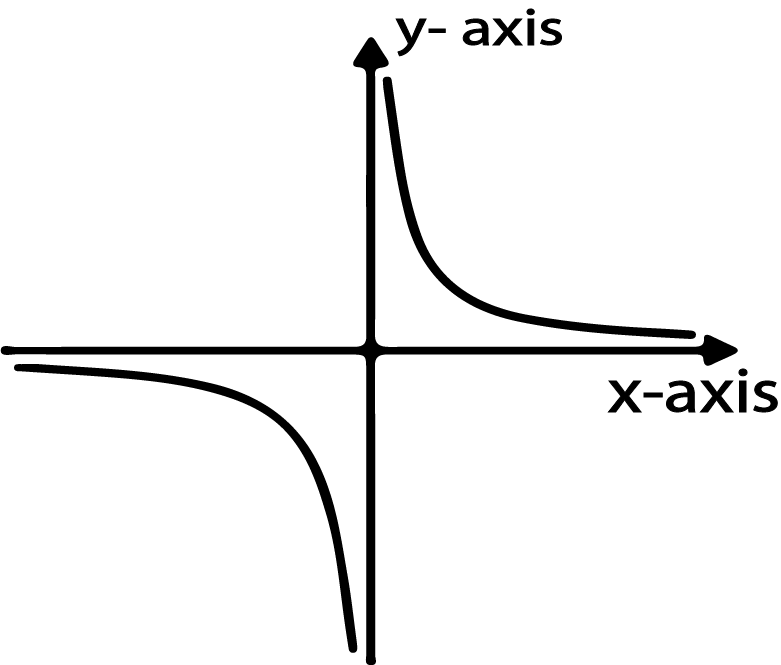
Foci:
Directrices:
Latus Rectum (l):
Parametric equation
Equation of a chord joining the points
Equation of the tangent at
Equation of the normal at
Important Highlights:
(i) Locus of the feet of the perpendicular drawn from focus of the hyperbola
(ii) The portion of the tangent between the point of contact & the directrix subtends a right angle at the corresponding focus.
(iii) The tangent & normal at any point of a hyperbola bisect the angle between the focal radii. This spell the reflection property of the hyperbola as "An incoming light ray" aimed towards one focus is reflected from the outer surface of the hyperbola towards the other focus. It follows that if an ellipse and a hyperbola have the same foci, they cut at right angles at any of their common point.
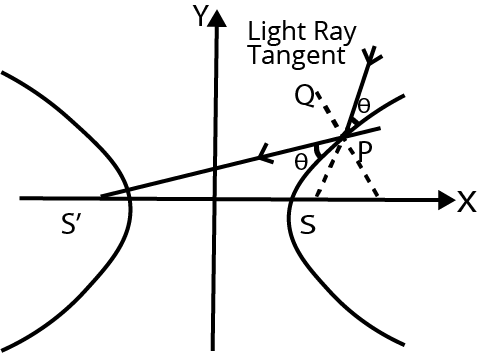
Note that the ellipse
(iv) The foci of the hyperbola and the points
(v) If from any point on the asymptote a straight line be drawn perpendicular to the transverse axis, the product of the segments of this line, intercepted between the point and the curve is always equal to the square of the semi conjugate axis.
(vi) Perpendicular from the foci on either asymptote meet it in the same points as the corresponding directrix and the common points of intersection lie on the auxiliary circle.
(vii) The tangent at any point
(viii) If the angle between the asymptote of a hyperbola
(ix) A rectangular hyperbola circumscribing a triangle also passes through the orthocentre of this triangle,
If
Q , R ,then orthocentre is
(x) If a circle and the rectangular hyperbola
(a)
(b) the centre of the mean position of the four, points bisects the distance between the centre of the circle through the points
Circle:
A circle is a locus of a point whose distance from a fixed point (called centre) is always constant (called radius).
1. Equation of Circle in Various Forms:
(a) The circle with centre as origin & radius '
(b) The Circle with centre
(c) The general equation of a circle is
Note that every second degree equation in
(d) The equation of circle with
Note that this will be the circle of least radius passing through
2. Intercepts Made by Circle on the Axes:
The intercepts made by the circle
3. Parametric Equation of the Circle:
The parametric equations of
4. Position of a Point with Respect to a Circle:
The point
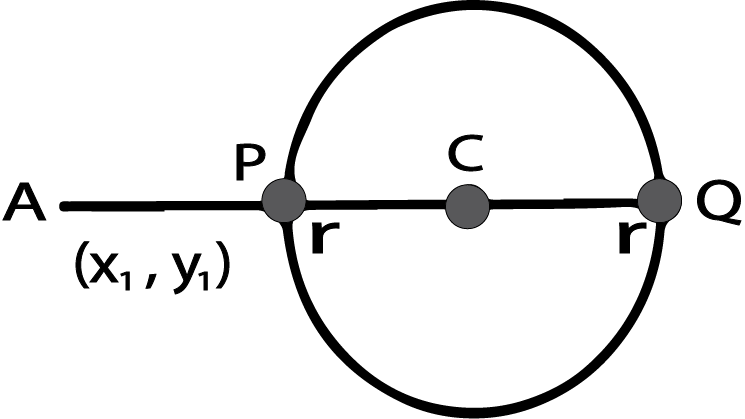
According as
Note: The greatest & the least distance of a point A from a circle with centre C
5. Line and a Circle:
Let
(i)
(ii)
(It is tangent to the circle)
(iii)
iv)
Also, if
i)
(ii)
(iii)
6.Tangent:
(a) Slope form:
Hence, equation of tangent is
(b) Point form :
(i) The equation of the tangent to the circle
(ii) The equation of the tangent to the circle
Where
Note:
In general the equation of tangent to any second degree curve at point
(c) Parametric form The equation of a tangent to circle
Note: The point of intersection of the tangents at the points
7. Family of Circles:
(a) The equation of the family of circles passing through the points of intersection of two circles
(b) The equation of the family of circles passing through the point of intersection of a circle
(c) The equation of a family of circles passing through two given points
where
(d) The equation of a family of circles touching a fixed line
Note:
Family of circles circumscribing a triangle whose sides are given by
Equation of circle circumscribing a quadrilateral whose side in order are represented by the lines
8. Normal:
If a line is normal/orthogonal to a circle then it must pass through the centre of the circle. Using this fact normal to the circle
9. Pair of Tangents From a Point:
The equation of a pair of tangents drawn from the point
10. Length of Tangent and Power of a Point:
The length of a tangent from an external point
Square of length of the tangent from the point
Power of a point
11. Director Circle:
The locus of the point of intersection of two perpendicular tangents is called the director circle of the given circle. The director circle of a circle is the concentric circle, having radius equal to
12. Chord of Contact:
If two tangents
Here
Note:
(a) Chord of contact exists only if the point 'P' is not inside.
(b) Length of chord of contact
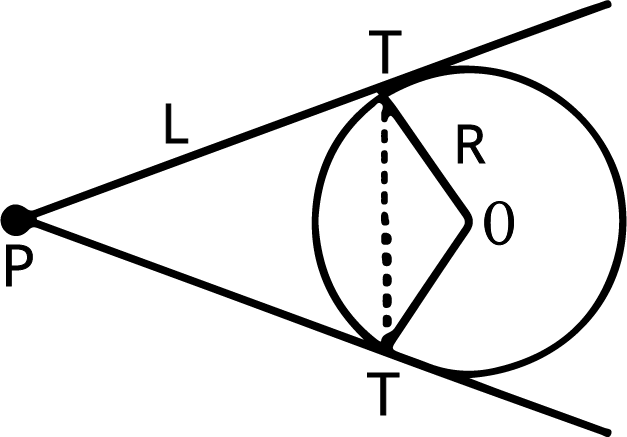
(c) Area of the triangle formed by the pair of the tangents & its chord of contact
(d) Tangent of the angle between the pair of tangents from
(e) Equation of the circle circumscribing the triangle
13. Pole and Polar (Not in syllabus):
(i) If through a point
(ii) The equation of the polar of a point
(iii) Pole of a given line
(iv) If the polar of a point P pass through a point
(v) Two lines
14. Equation of Chord with a Given Middle Point:
The equation of the chord of the circle
Note:
(i) The shortest chord of a circle passing through a point
(ii) The chord passing through a point
15. Equation of the Chord Joining Two Points of the Circle:
The equation of chord
16. Common Tangents to the Two Circle:
(i)
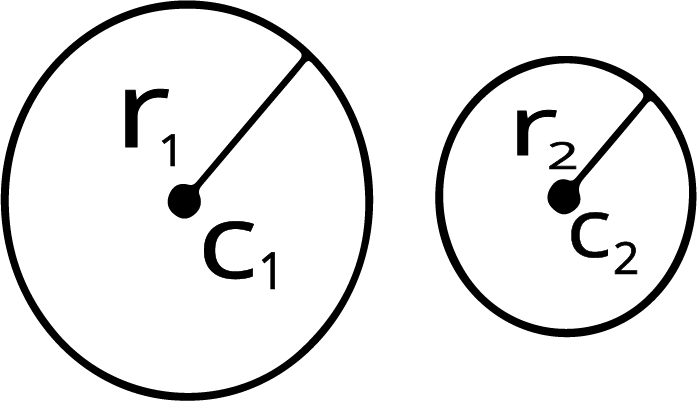
4 common tangents (2 direct and 2 transverse)
(ii)
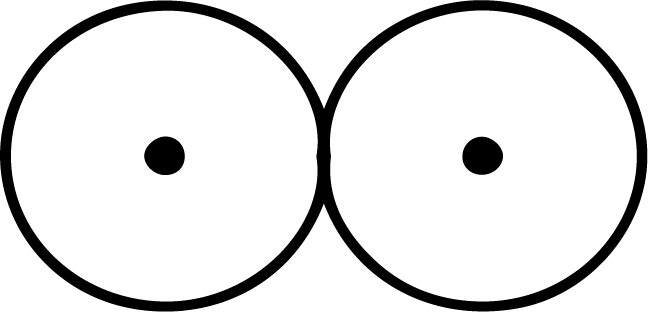
3 common tangents
(iii)
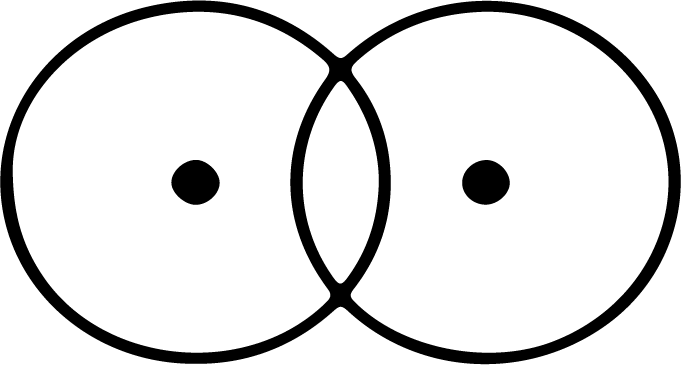
2 common tangents
(iv)
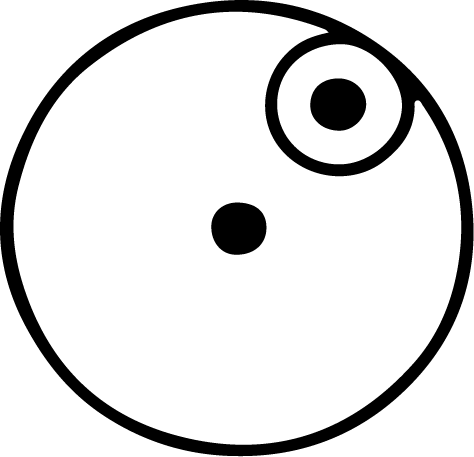
1 common tangent
(v)

No common tangent
(Here ,
Note:
(i) The direct common tangents meet at a point which divides the line joining centre of circles externally in the ratio of their radii.
Transverse common tangents meet at a point which divides the line joining centre of circles internally in the ratio of their radii.
(ii) Length of an external (or direct) common tangent & internal (or transverse) common tangent to the two circles are given by :
17. Orthogonality of Two Circles:
Two circles
Note:
(a) The centre of a variable circle orthogonal to two fixed circles lies on the radical axis of two circles.
(b) If two circles are orthogonal, then the polar of a point 'P' on first circle w.r.t. the second circle passes through the point
(c) The centre of a circle which is orthogonal to three given circles is the radical centre provided the radical centre lies outside all the three circles.
18. Radical Axis and Radical Centre:
The radical axis of two circles is the locus of points whose powers w.r.t. the two circles are equal. The equation of radical axis of the two circles
The common point of intersection of the radical axes of three circles taken two at a time is called the radical centre of three circles. Note that the length of tangents drawn from radical centre to the three circles are equal.
Note:
(a) If two circles intersect, then the radical axis is the common chord of the two circles.
(b) If two circles touch each other then the radical axis is the common tangent of the two circles at the common point of contact.
(c) Radical axis is always perpendicular to the line joining the centers of the two circles.
(d) Radical axis will pass through the mid-point of the line joining the centers of the two circles only if the two circles have equal radii.
(e) Radical axis bisects a common tangent between the two circles.
(f) A system of circles, every two of which have the same radical axis, is called a coaxal system.
(g) Pairs of circles which do not have radical avis are concentric.
Revision Notes For CBSE Class 11 Maths Chapter 10
Conic Sections: Class 11 Maths Chapter 10 Revision Notes Summary
This chapter is different from that of what you have studied in coordinate geometry. This time, you will study how the syllabus proceeds to a higher level of concepts. You will learn the complex representation of the conic sections. You will also learn the features of those sections and how they are represented on a 2D plane. Let us take a look into Class 11 Maths Revision Notes Chapter 10 and check how you can get help from them.
This chapter begins with the introduction to circles. Students will learn how circles are formed using an equation. There are different kinds of equations described in the chapter that represent a particular set of features of a circle. By learning these equations, you can calculate the radius of a circle, the centre, and other intersection points. This chapter is very crucial for the students as they will need it in the higher classes for equating values of such shapes.
On proceeding further in the Conic Sections Class 11 Notes, you will find the proper explanation of parabolas. In the chapter, you will learn what parabolas are and how they can be represented by an equation. The formula of the parabolas is entirely different from what you have studied. It is quite interesting to learn and remember. This equation will also help you find out the different features of a parabolic curve on a 2D plane. This conic section does not have a centre but a focal point. the behaviour of the X and Y coordinates follow the respective formulas of the curves.
Moving ahead, you will learn what an ellipse is. All elliptical curve has two focal points. The salient feature of that the sum of the distances of any point on this curve is always equal at any instance. Ellipses have their equation that represents the features aptly. Follow the Notes of Class 11 Revision Notes Chapter 10 and find the different features of an ellipse to remember.
Hyperbola is the next concept you will learn in this chapter. This conic section is represented by its equation that perfectly depicts the behaviour of the coordinate points forming the curve. If you follow the Maths Class 11 Conic Sections Notes, you will be able to recall these features along with the equations.
This is how you can use Class 11 Maths Notes of Conic Sections to recapitulate what you have studied in this chapter.
Why Should You Use Class 11 Maths Chapter 10 Revision Notes?
Vedantu has been the primary choice for students of Class 11 for all subjects. The teachers formulate the revision notes in such a way that the students can remember the formulas and concepts easily. The Revision Notes Class 11 Maths Chapter 10 are quite helpful in preparing and revising this chapter before an exam.
Related Study Materials for Class 12 Maths Chapter 10
Conic Sections Related Other Study Materials |
Chapter-wise Links for Mathematics Class 11 Notes
S.No. | NCERT Solutions Class 11 Maths All Chapters |
1 | |
2 | |
3 | |
4 | |
5 | |
6 | |
7 | |
8 | |
9 | |
10 | Chapter 11 - Introduction To Three Dimensional Geometry Notes |
11 | |
12 | |
13 |
Related Important Links for Mathematics Class 11
Along with this, students can also download additional study materials provided by Vedantu for Maths Class 11–
S. No | Important Study Material for Class 11 Maths |
1. | |
2. | |
3. | |
4. | |
5. | |
6. |
FAQs on Conic Sections Class 10 Notes CBSE Maths Chapter 10 (Free PDF Download)
1. How are curves defined on a coordinate plane?
The behaviour of a point on a coordinate plane is tracked and plotted according to an equation. The conic sections are represented using such equations. Every point on the curves will have to follow the equation. Follow Class 11 Revision Notes Maths Chapter 10 to remember the formulas.
2. How can you revise Chapter 10 Conic Sections?
Once you are done with the chapter, proceed to the respective exercises and learn how to approach the specific problems. Before an exam, you can refer to Class 11 Revision Notes Conic Sections. It will help you remember the equations and the specific features of every conic section.
3. How many exercise questions are there in Class 11 Maths Chapter 10?
There are a total of 4 exercises and one miscellaneous exercise in the NCERT Maths Class 11 Chapter 10 Conic Sections. The number of questions in each exercise is given below -
Exercise 11.1 - 15
Exercise 11.2 - 12
Exercise 11.3 - 20
Exercise 11.4 - 15
Miscellaneous Exercise - 8
Students can find easy-to-understand and well-explained revision notes prepared by experts at Vedantu that are available free of cost. It will help students clarify all their doubts and gain confidence in the topic.
4. What are the important concepts in NCERT Class 11 Maths Chapter 10?
The important topics covered in NCERT Class 11 Maths Chapter 10 Conic Sections are -
The definition of a circle
The definition of an ellipse
The definition of a parabola
The definition of the hyperbola
Latus rectum of parabola, ellipse and hyperbola
The eccentricity of a hyperbola
The eccentricity of an ellipse
Length of Latus rectum of ellipse and hyperbola.
These important topics should be covered by the student by practicing the exercise questions which will help them understand the topic better.
5. What is the Latus rectum and what does it mean in a parabola and ellipse?
Latus rectum by definition is a line segment that is perpendicular to a given axis. In a parabola, the Latus rectum is the line segment that is perpendicular to the axis of the parabola and passes through the focus. Its endpoints lie on the parabola. In an ellipse, the Latus rectum is a line segment that is perpendicular to the main axis through any of the foci and whose endpoints lie on the ellipse.
6. Which questions and examples are important in NCERT Class 11 Maths Chapter 10?
The important questions in NCERT Class 11 Maths Chapter 10 Conic Sections that students must focus on include -
Finding the eccentricity of the latus rectum of a hyperbola.
Finding the length of the latus rectum of a parabola and ellipse.
Finding the foci and vertices of the coordinates of a hyperbola.
Finding the eccentricity of an ellipse.
Standard equations of parabola under different coordinates of the vertex, focus and directrix.
Standard equations of hyperbolas.
7. What are the most important formulas that I need to remember in Class 11 Maths Chapter 10?
The most important formulas in NCERT Class 11 Maths Chapter 10 Conic Sections that students should practice thoroughly are -
Standard equations of parabola.
Standard equations of hyperbolas.
Standard equations of ellipses.
Eccentricity of hyperbola.
The eccentricity of an ellipse.
Latus rectum of parabola and ellipse.
Length of the latus rectum of parabola and ellipse.
Equation of an ellipse having its foci on the x-axis.
Equation of the hyperbola having its foci on the x-axis.

















